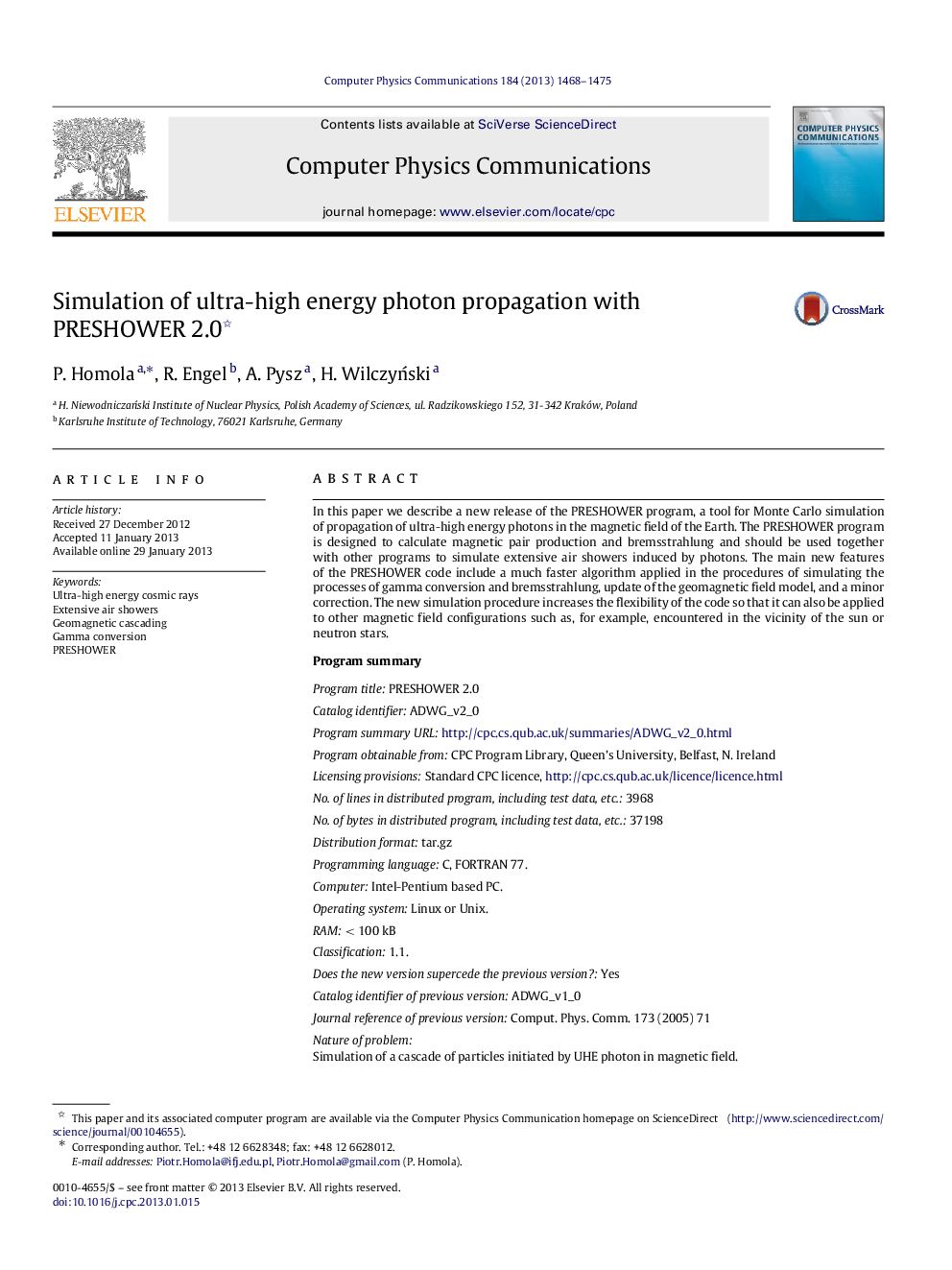| کد مقاله | کد نشریه | سال انتشار | مقاله انگلیسی | نسخه تمام متن |
|---|---|---|---|---|
| 502972 | 863733 | 2013 | 8 صفحه PDF | دانلود رایگان |

In this paper we describe a new release of the PRESHOWER program, a tool for Monte Carlo simulation of propagation of ultra-high energy photons in the magnetic field of the Earth. The PRESHOWER program is designed to calculate magnetic pair production and bremsstrahlung and should be used together with other programs to simulate extensive air showers induced by photons. The main new features of the PRESHOWER code include a much faster algorithm applied in the procedures of simulating the processes of gamma conversion and bremsstrahlung, update of the geomagnetic field model, and a minor correction. The new simulation procedure increases the flexibility of the code so that it can also be applied to other magnetic field configurations such as, for example, encountered in the vicinity of the sun or neutron stars.Program summaryProgram title: PRESHOWER 2.0Catalog identifier: ADWG_v2_0Program summary URL:http://cpc.cs.qub.ac.uk/summaries/ADWG_v2_0.htmlProgram obtainable from: CPC Program Library, Queen’s University, Belfast, N. IrelandLicensing provisions: Standard CPC licence, http://cpc.cs.qub.ac.uk/licence/licence.htmlNo. of lines in distributed program, including test data, etc.: 3968No. of bytes in distributed program, including test data, etc.: 37198Distribution format: tar.gzProgramming language: C, FORTRAN 77.Computer: Intel-Pentium based PC.Operating system: Linux or Unix.RAM: << 100 kBClassification: 1.1.Does the new version supercede the previous version?: YesCatalog identifier of previous version: ADWG_v1_0Journal reference of previous version: Comput. Phys. Comm. 173 (2005) 71Nature of problem:Simulation of a cascade of particles initiated by UHE photon in magnetic field.Solution method:The primary photon is tracked until its conversion into an e+ e− pair. If conversion occurs each individual particle in the resultant preshower is checked for either bremsstrahlung radiation (electrons) or secondary gamma conversion (photons).Reasons for new version:1.Slow and outdated algorithm in the old version (a significant speed up is possible);2.Extension of the program to allow simulations also for extraterrestrial magnetic field configurations (e.g. neutron stars) and very long path lengths.Summary of revisions:A veto algorithm was introduced in the gamma conversion and bremsstrahlung tracking procedures. The length of the tracking step is now variable along the track and depends on the probability of the process expected to occur. The new algorithm reduces significantly the number of tracking steps and speeds up the execution of the program. The geomagnetic field model has been updated to IGRF-11, allowing for interpolations up to the year 2015. Numerical Recipes procedures to calculate modified Bessel functions have been replaced with an open source CERN routine DBSKA. One minor bug has been fixed.Restrictions:Gamma conversion into particles other than an electron pair is not considered. Spatial structure of the cascade is neglected.Additional comments:The following routines are supplied in the package, IGRF [1, 2], DBSKA [3], ran2 [4]Running time:100 preshower events with primary energy 10201020 eV require a 2.66 GHz CPU time of about 200 sec.; at the energy of 10211021 eV, 600 sec.References:[1]C. C. Finlay et al., Geophys. J. Int., 183, (2010), 1216, doi: 10.1111/j.1365-246X.2010.04804.x, http://www.ngdc.noaa.gov/IAGA/vmod/igrf.html[2]N. A. Tsyganenko, Institute and Department of Physics, Saint- Petersburg State University, Russia, private communication; http://geo.phys.spbu.ru/?tsyganenko/Geopack-2008.html[3]http://wwwasdoc.web.cern.ch/wwwasdoc/shortwrupsdir/c341/top.html[4]Numerical Recipes, http://www.nr.com
Journal: Computer Physics Communications - Volume 184, Issue 5, May 2013, Pages 1468–1475